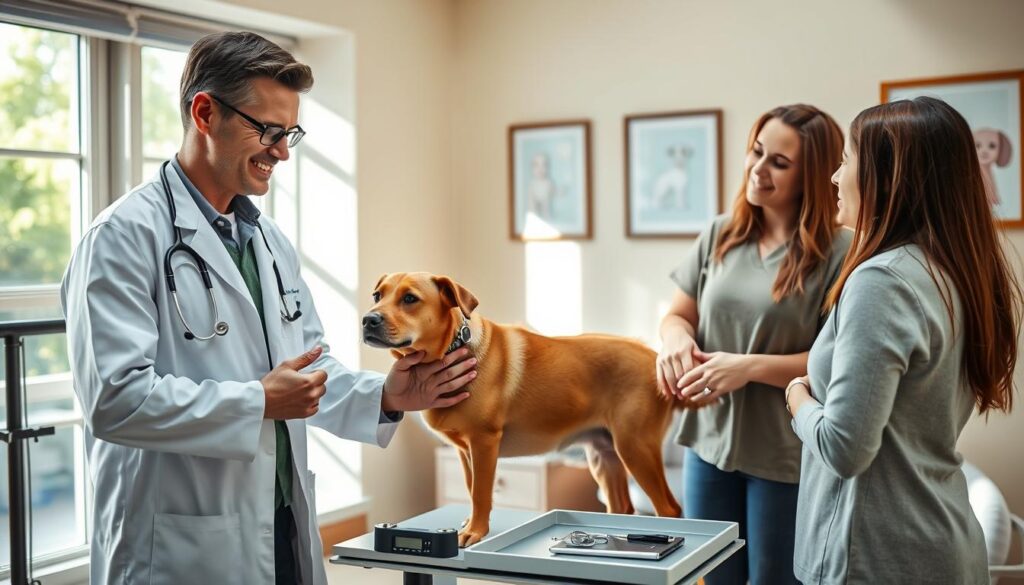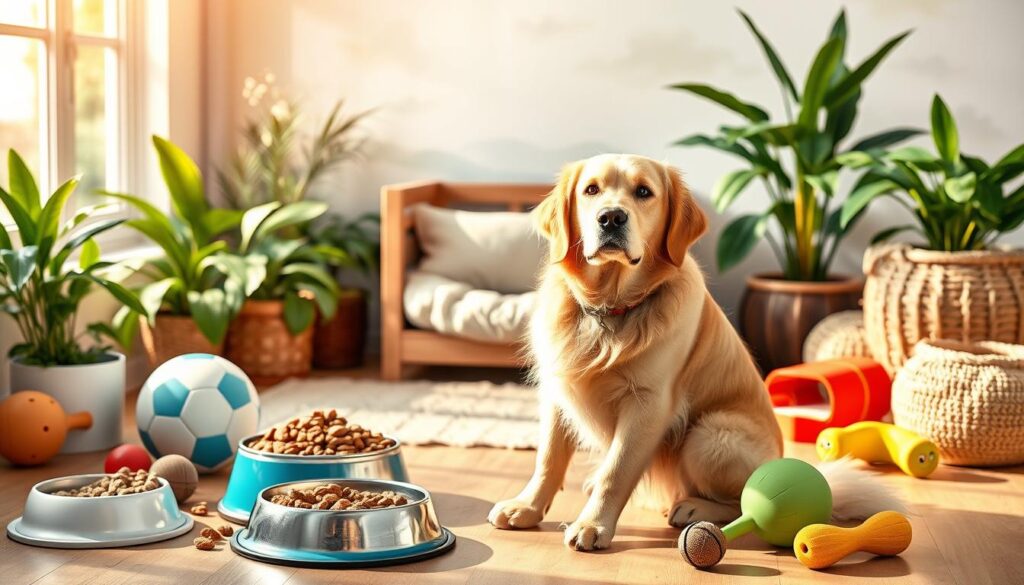Every dog owner wants their pet to be happy and healthy. This guide gives you practical tips to achieve that. You’ll learn about daily routines and vet visits to support your dog’s well-being at every stage of life.
If you’re new to dog ownership or have been for a while, these tips are for you. They cover important topics like nutrition, exercise, and training. You’ll find out how to balance love with the right tools to help your dog stay physically and emotionally strong.
Table of Contents
ToggleKey Takeaways
- Learn actionable dog care tips to improve your dog’s diet, exercise, and mental stimulation.
- Discover how preventative healthcare and vet visits protect your dog’s long-term health.
- Understand the role of training and socialization in building a strong owner-pet bond.
- Get advice on creating safe, engaging environments for your dog’s comfort.
- Explore seasonal care strategies to keep your dog safe in all weather conditions.
Understanding Your Dog’s Health and Happiness
Every wag or whine tells us something about our dog’s health. Canine health insights begin with watching their daily actions. Dogs speak through body language—tails, ears, and eyes share stories without words.
- Relaxed posture with a loose body
- Play bows and energetic tail wags
- Soft, blinking eyes
Stress signals may include:
- Yawning when no sleepiness exists
- Heavy panting without exercise
- Flattened ears or tucked tail
| Happy Signals | Stressed Signals |
|---|---|
| Playful barking | Excessive whining |
| Curious exploration | Withdrawn behavior |
| Normal eating habits | Loss of appetite |
Mental stimulation is as important as physical care. Dogs need puzzles, training, and interactive play. By noticing these signs, we build trust and strengthen our bond. Small changes based on these canine health insights can make a big difference in their happiness.
Nutrition and Diet for a Healthy Dog
A well-balanced diet is key for canine nutrition. It helps your dog stay healthy and happy. Here’s how to make sure they get the right food.
Essential Nutrients for Canine Health
Dogs need certain nutrients to stay healthy. These include:
- Proteins: Help build muscles and keep the immune system strong (chicken, fish, or beef).
- Buy on Amazon
- Buy on Amazon
- Buy on Amazon
- Fats: Give energy and keep the skin and coat healthy (like omega-3 fatty acids).
- Vitamins and Minerals: Help with metabolism and bone strength (from vegetables or fortified foods).
- Water: Always have fresh water ready.
| High-Quality Ingredients | Low-Quality Ingredients |
|---|---|
Real meat as the first ingredient | Meat by-products |
Whole grains (oats, brown rice) | Corn syrup or fillers |
Natural preservatives | Artificial additives |
Balanced Meal Planning
Here’s how to plan meals for your dog:
- Pick premium brands: Choose brands like Blue Buffalo Life Protection Buy on Amazon or Orijen Buy on Amazon for real ingredients.
- Portion control: Adjust portions based on age, size, and activity level. Too much food can cause obesity.
- Add variety: Mix up proteins and textures to keep meals interesting and full of nutrients.
Ask your vet to help make meals fit your dog’s specific needs. Even small changes can make a big difference in their health and life span.
Daily Routines: how to take care of your dog
Exercise is crucial for your dog’s happiness. Active breeds like Labs need over an hour of walks each day. Seniors might do better with shorter walks. Try different activities like fetch or swimming to keep them interested.
Exercise and Activity Tips
- Rotate playtime locations: parks, trails, or even backyard obstacle courses
- Use puzzle toys to stimulate mental exercise indoors
- Adjust intensity based on age and breed energy levels
| Breed | Daily Exercise |
|---|---|
| Labrador Retriever | 1.5-2 hours |
| French Bulldog | 30-45 minutes |
| Border Collie | 2+ hours |
Maintaining a Consistent Schedule
A routine helps reduce stress. Here’s a simple daily plan:
- Morning: Walk + breakfast within 30 minutes of waking
- Afternoon: Play session or training break
- Evening: Dinner followed by final walk before bedtime
“Consistency builds trust. Dogs thrive when they know what comes next.” – American Veterinary Medical Association
Include grooming and potty breaks at the same times every day. Even short training sessions can become fun routines.
Creating a Safe and Stimulating Environment for Your Dog
A safe and fun space is crucial for your dog’s happiness every day. First, get rid of dangers like small things, poisonous plants, or harmful chemicals. Use baby gates or locks to block off risky spots. This lets your dog play safely without worry.
- Store medicines and cleaners in secure cabinets.
- Choose chew toys rated for your dog’s size and strength.
- Install fencing in yards to prevent escapes or injuries.
Keep your dog’s mind and body active with fun puzzles and toys. Change toys every week to keep things exciting. A comfy bed in a quiet spot is great for rest. Plus, open areas for running help keep them fit. Mental and physical stimulation are both important in a safe space.
Don’t forget about outdoor areas. A grassy play area is safer than hard surfaces. Stay away from hot spots like enclosed patios in summer. Regularly check your home’s layout to keep it safe as your dog grows or gets older.
“A safe space builds trust. Your dog’s environment should encourage exploration while shielding it from harm.”
Small changes can make any place a great spot for your dog. Focus on safety without losing the fun. A balanced, engaging space makes your dog happy.
Training Techniques and Behavioral Tips
Positive dog training builds strong bonds and confident pets. It uses kind and clear methods to guide your dog’s behavior.
Positive Reinforcement Methods
“Rewards build trust faster than punishment ever could.” – American Humane Society
Here are steps for effective training sessions:
- Give TREATS Buy on Amazon
- Buy on Amazon
- Buy on Amazon or toys when your dog does what you ask.
- Use calm, upbeat tones with rewards to encourage good behavior.
- Keep sessions short and fun to keep your dog engaged.
Effective Socialization Strategies
Introduce your dog to new things slowly. Try this:
| Scenario | Action |
|---|---|
| Parks | Use a leash and praise calm behavior. |
| Visitors | Ask guests to toss treats as a friendly greeting. |
| Busy streets | Practice walking calmly with high-value rewards. |
Obedience Training Essentials
Learn these commands to improve safety and harmony:
Core Commands:
- Sit before meals to establish structure.
- Leave It prevents dangerous item chewing.
- Come ensures recall in emergencies.
Use hand signals with each command for clarity. Regular practice helps build strong habits.
Preventative Healthcare and Regular Vet Visits
Vet checkups are key to your dog’s health. They catch problems early, keeping your pet happy and active. Regular care stops small issues from getting worse.
Prevention is better than cure. Early detection during vet checkups can save your dog from avoidable health struggles.

Important Vaccinations and Preventatives
Dogs need core vaccines like rabies, distemper, and parvovirus to stay safe. Also, talk to your vet about preventatives for fleas, ticks, and heartworm. These steps protect against common dangers.
- Rabies vaccine: Required by law in most states
- Heartworm pills: Protect against deadly parasites
- Flea/tick treatments: Available in chewable or topical forms
Scheduling Routine Check-Ups
Make sure to schedule annual vet checkups, even if your dog seems fine. Puppies might need more visits. Vets will check teeth, weight, and listen to the heart. Bring a list of questions about diet or behavior changes.
Use apps like PetDesk or calendar reminders to keep track of appointments. Senior dogs over 7 years may need checkups every six months to watch for age-related changes.
Managing Common Canine Health Issues
Understanding early signs of discomfort is key to managing dog health issues. Common problems include allergies, skin irritations, and mobility challenges. Quick action and consistent care help pets stay comfortable between vet visits.
- Environmental allergies causing itching or redness
- Hot spots from licking or scratching
- Joint stiffness in older dogs
- Ear infections with smelly discharge
- Upset stomach from dietary changes
| Issue | At-Home Steps |
|---|---|
| Allergies | Wipe paws after walks. Use oatmeal shampoos for relief. |
| Hot Spots | Clean affected areas gently. Trim fur to allow airflow. |
| Arthritis | Provide orthopedic dog beds. Encourage short walks daily. |
| Ear Infections | Clean ears weekly with vet-approved solutions. |
| Upset Stomach | Switch to pumpkin-rich diets. Avoid table scraps. |
Always consult a veterinarian if symptoms persist. Regular grooming and vet check-ups strengthen your approach to managing dog health issues. Small daily actions like monitoring food or checking paws build long-term wellness.
Seasonal Care for Your Dog
Seasonal changes require special care for pets to stay safe and happy. Seasonal dog care means adjusting routines for extreme weather. This ensures your dog’s comfort all year round. Here’s how to get ready:

Summer Safety Tips
Stay cool with these tips:
- Always carry water bottles during walks. Use collapsible bowls for easy access.
- Avoid asphalt surfaces; hot pavement can burn paws. Walk in grassy areas instead.
- Trim long-haired breeds cautiously—never shave close to the skin. Leave at least an inch of fur for sun protection.
Winter Care Guidelines
Cold weather calls for extra care:
- Dress pets in waterproof jackets for extreme cold. Look for brands like Ruff Wear or Hurtta for reliable options.
- Wipe paws with pet-safe wipes after walks to remove salt or ice melt residue.
- Keep heated floors or mats in high-traffic indoor areas to prevent hypothermia.
| Season | Priorities |
|---|---|
| Summer | Hydration, paw protection, sun safety |
| Winter | Insulated gear, paw care, indoor climate control |
Fun Activities to Keep Your Dog Engaged
Dogs enjoy playing and exploring. Fun dog activities keep them happy and sharp. Try these ideas to make every day exciting.
Interactive Games and Toys
- Puzzle toys like KONG or Outward Hound’s Busy Buddy keep minds active.
- Play fetch with durable balls or flying discs for exercise and bonding.
- Hide treats around the house and let them sniff them out—great mental stimulation.
Outdoor Adventures and Play
Take your dog outside for fresh air and adventure:
- Visit dog-friendly trails for hiking. Check local parks like Central Park or Discovery Park for safe paths.
- Try agility courses at parks or backyard setups using tunnels and jumps.
- Swimming in lakes or pools (ensure safety with a life jacket).
Rotate activities to avoid boredom. A stimulated dog is a happy dog. Mix playtime with learning for a balanced routine.
Conclusion
Starting your dog’s wellness journey is simple. A good diet, exercise, and mental games are key. Small actions like walks or training sessions help a lot.
Love and care in your daily routine make your dog happy. Try something new today, like healthier snacks or a vet visit. These small steps make a big difference in your bond.
Remember, it’s not about being perfect. It’s about making thoughtful choices every day. Your dog will feel happier and more energetic as you care for them. Every effort you make today will help your dog stay healthy tomorrow.
FAQ
How can I tell if my dog is happy?
A happy dog wags its tail and looks relaxed. They might bark playfully and want to play with you. These signs show they’re in a good mood.
What should I feed my dog to ensure they have a balanced diet?
Feed your dog high-quality protein, fats, and fruits and veggies. Talk to your vet to find out what’s best for your dog’s age, breed, and health.
How much exercise does my dog need daily?
Dogs need 30 minutes to two hours of exercise daily. This can be walks, playtime, or outdoor activities. It keeps them active and happy.
What are the best training techniques for my dog?
Use positive reinforcement like treats and praise for training. Be consistent and patient. Also, socialize your dog to meet new people and places.
How often should I take my dog to the vet?
Healthy adult dogs need annual vet visits. Puppies and seniors might need more. Regular vet visits catch health problems early and keep your dog up-to-date on shots.
What are common signs of health issues in dogs?
Watch for vomiting, diarrhea, changes in appetite or behavior, itching, and trouble moving. If you see these signs, see your vet right away.
How can I create a safe environment for my dog at home?
Make your home safe by removing hazards and providing toys. Give your dog a cozy spot to relax. Check for dangers like electrical cords or small objects.
What should I do during seasonal changes to keep my dog comfortable?
In warm weather, give your dog fresh water and shade. In winter, keep them warm with the right gear. Always adjust your care routine for the season.
What types of activities can I do with my dog to keep them engaged?
Play games like fetch or hide and seek. Take them on hikes or to dog parks. Mix it up to keep your dog happy and engaged!

